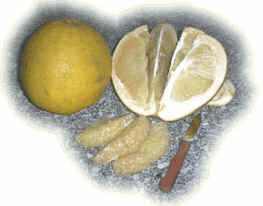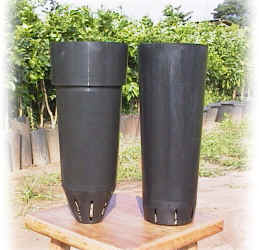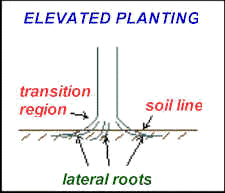
| New Pummelos for the Dooryard Orchard. Two new pummelo varieties (Citrus grandis) have been released by Agrocitros Citrolima for the dooryard orchard. Pummelos are citrus fruit typically used for fresh consumption whose main characteristics are their large size and exotic flavor, similar to grapefruits. Fruits commonly weigh 2 to 3 kg (4 to 7 lb). The rind is thick and can be used for making sweet preserves. The released varieties resulted from selections among seedlings under observation for the last 15 years. They are named after the person who planted them and is an avid appreciator of their fruit. The variety ‘Perina 1’ is seedy, light pink internally, slightly acid, with firm but juicy segments, whereas ‘Perina 2’ is seedless, internally more pink, less acid and has firmer segments. Both are flavorful, and their plants and fruit are very attractive. | 
|
 |
New Containers for Nursery Trees. Agrocitros Citrolima in association with Pissardi Plásticos developed new containers for the citrus nursery. The "citritubo" model imitates the "tubetes" utilized in the production of rootstock liners, while the "citrivaso" model improves upon its previous version released in 1994. Both are conical, have excellent drainage characteristics, and possess internal ridges which prevent pot-bound curled roots typical of plants grown in plastic bags. Citrus plants are highly sensitive to pot-bound roots which result in significant reduction of tree vigor. The production of rootstock liners in plastic bags, for instance, is not recommended. The citritubos have 15 x 35 cm (4.5 l) [6 x 14 in, 1.2 gal] and have to be hanged by the collar ca. 8 cm (3 in) below the rim. The citrivasos have 14 x 35 cm (4,2 l) [ 5.5 x 14 in, 1,1 gal) with an 11 cm (4.3 in) base and can be placed directly over benches. Citrus plants produced in these containers have shown excellent performance in the nurseries. |
| Potted Citrus Trees. It is now easier to grow citrus plants in pots as ornamentals due to a special dwarfing rootstock. This rootstock is called Flying Dragon and originated in China. Besides the dwarfing effect, this rootstock also induces sweeter fruits. All commercial citrus varieties can be grafted on this rootstock, which include oranges, tangerines, and lemons, among others. The fruit is perfectly edible but their ornamental value on the trees is much greater. The esthetic effect of fruiting citrus plants in vases is very interesting and has pleased immensely clients and collectors. Final tree height depends on pot size. Five-gallon pots will give 3- to 4-foot tall plants with up to 8 fruits after thinning. |
|
|
|
"Madre Teresa" (Mother Theresa), a new tangerine for the dooryard orchard. Agrocitros Citrolima has selected a clone of tangerine in 1994, from plants of a tangerine variety known in South Minas Gerais by the name "Cara de Velha" (Old Woman's Face). This clone is now being released to the citrus industry under the name "Madre Teresa". It is a thick-peel tangerine, very sweet and with lemon-type fragrance. Internal and external color is dark yellow to orange. Fruit size is medium. Maturity occurs early winter, as a midseason fruit, with typically 35% juice content and 14% to 16% Total Soluble Solids. The fruit are recommended for fresh consumption due to the sweet flavor and exquisite fragrance, but they excel as sweet preserves made with peel and pulp. Leaves are typical of tangerines and plant-growth is more lateral, like the Satsumas. The only rootstock compatibility confirmed so far has been with Rangpur lime. Seeds are monoembryonic. |
|
|
|
How to Transport, Store, and Plant Citrus Trees. It is very important to prevent water loss by
nursery trees during transporting due to high temperature and wind. The best time
for transporting is during the night or when temperature is mild. The trailer should be
entirely closed, or, if open, the top should be covered
with shade cloth. Most importantly, the trailer should be cleaned,
washed and sterilized prior to arrival to the nursery, to prevent
contamination by soil born or aerial diseases. Citrus trees are generally very susceptible to high humidity in the soil. The main consequence is foot rot, which may weaken and kill the plant. Correct handling of the nursery trees during storage, prior to delivery, is very important to keep the trunk and the roots free from diseases. In our nurseries, the trees are stored on decks or benches, elevated 30 cm off the ground, for at least 2 weeks. The objective is to maintain ideal conditions for the perfect healing of the root system. Trees should be planted immediately after removal from the storage area by the grower. If they must be stored, the conditions have to be similar to those of the nursery: store in full sun, on elevated benches or, at least, on paved ground avoiding water logging, and with fungicidal treatment. Irrigation should be minimal, only when necessary, more around the borders of the bed of trees than in the middle. |
|
 |
The mistake to avoid during planting is to allow moisture to collect around the trunk of the trees, specially on the transition region, the area between the root system and the trunk. It is essential to keep the transition region above the soil line, using the "elevated planting". The dorsal region of the first lateral roots should also remain above the soil line, as shown in the figure. The best procedure for planting our burlap wrapped trees is to place the root ball in the planting hole leaving the last 2 inches of the ball above the soil line. Fill up the hole around the ball compacting the soil continually. Before the hole is completely filled, cut the string that ties the wrap and spread the borders of the tissue over the soil around the tree. Complete the filling of the hole, compacting the soil very well around the root ball. A water ring with approximately 2 feet upper-diameter should be built around the tree to collect irrigation water. |
|
Irrigation is very critical. Apply approximately 6 gallons of
water per tree in the water rings shortly after planting. Water once or twice a week,
with ca. 3 gallons per plant. Water only if necessary, avoiding over
irrigation. Reduce irrigation to once a week as soon as possible. Only
use water free of disease organisms or nematodes. For
foot-rot susceptible rootstocks, or soils previously planted with citrus, apply
Metalaxyl and Aldicarb as directed by the manufacturers.
Fertilization should start 30 days (summer) or 60 days (winter) after planting. Trees should receive at least a1 lb. of 10-10-10 formula or equivalent during the first year. Start with 0.1 lb. per plant in the first 2 applications, followed by 4 others of 0.2 lb. each during the growing cycle. |
|
HOME PAGE CONTENTS
ABOUT
US OUR TREES PRODUCTS/SERVICES NEWSLETTER LINKS E-MAIL